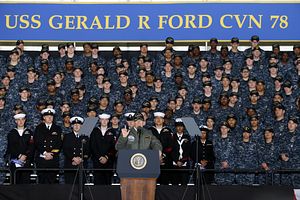President Donald Trump’s 2018 budget request, released this week, contained only modest defense increases and little investment toward the expanded 350-plus-ship fleet promised during his election campaign and advocated in the latest internal Navy force structure study. While the lack of significant new shipbuilding investment was a surprise to some, the budget was consistent with priorities the secretary of defense laid out in January.
The $603 billion defense budget is about 3 percent higher than the projected 2018 budget prepared by the Obama administration. The budget requests $19.9 billion for the Navy’s shipbuilding account, a little over one percent increase from the $19.3 billion requested for 2017. This pays for the same eight ships that the Navy had planned to buy under its 2017 30-year shipbuilding plan, which was designed to achieve and maintain the 308-ship fleet called for under its previous Force Structure Assessment, not the new 355-ship goal.
2018 Budget as a “Placeholder”
Expectations were high. Trump pledged during his campaign to build a 350-ship fleet and the Navy’s latest Force Structure Analysis calls for a minimum 355-ship fleet. The president has given speeches decrying the small size of today’s fleet; the Navy submitted a plan for accelerating ship construction; and the chairmen of both the House and Senate Armed Services Committees advocated for much higher defense budget that included substantial extra shipbuilding funds. The president’s 2018 budget blueprint said the 2018 submission would be designed to “[rebuild] the U.S. Navy to better address current and future threats by increasing the total number of ships” and reflect “a down payment on the president’s commitment to expanding the fleet”
But in the end the budget most closely resembled the priorities Defense Secretary James Mattis articulated in the budget guidance he issued in January. The 2018 budget submission, he said, would “focus on balancing the program, addressing programmatic shortfalls, while continuing to rebuild readiness” by buying critical munitions, improving facilities, and investing in demonstration technologies and critical enablers.
In other words, the Pentagon never intended to pursue a major fleet expansion this year. Defense officials and analysts have called this budget a “placeholder” to lay the groundwork for greater expenditures in the 2019 budget. The 2017 supplement and this 2018 budget will be used to repair gaps in readiness, training, and maintenance that have grown over the past 15 years of high operational demand, exacerbated by budget fights in Congress and across-the-board cuts mandated by the Budget Control Act since 2013.
While the budget does not buy any ships above previously planned levels this year,* it does obligate funds to build a second Virginia-class submarine in 2021, something advocated by the ranking member of the House Armed Services Committee, Joe Courtney (D-CT), whose district is home to one of the two U.S. shipyards that build submarines. The Navy has been building two Virginia-class submarines a year since 2014, but building a second in 2021 may prove challenging. The USS Columbia, the first of a new class to replace for the United States’ aging ballistic missile submarines, is also slated to begin construction in 2021 and is expected to strain the submarine builder’s capacity to keep the Virginia-class production on schedule.
In a press release, Representative Courtney lamented the budget submission as a missed opportunity to begin building the fleet up to the levels advocated by Navy and external studies, and by the combatant commanders who rely on the forces the Navy provides. Noting that shipbuilding “is a long game,” he said that “a year lost in shipbuilding can never be regained.” Such “lost years” are likely to have a major impact on the size of the fleet in decades to come as the Navy faces major waves of ship retirements in the 2020s.
Extra Capabilities for the Pacific
The extra Virginia-class submarine programmed for 2021 will be welcomed in the Pacific. Admiral Harry Harris, the head of Pacific Command, has repeatedly testified to Congress that he needs more submarines. He has said that he only gets about 50 percent of the submarines he needs for peacetime operations and patrols today, and is deeply concerned about a looming shortfall as older attack submarines begin to be retired faster than the new Virginia-class are being built. Under current projections, the Navy will drop from having 52 attack submarines to only 42 by the end of the 2020s.
Recognizing other warfighting priorities for the Pacific, the chairman of the House Armed Services Committee is proposing an additional $2 billion of replacement munitions and ballistic missile defense assets designated specifically to go to the Pacific Command. In the same hearing that he requested additional submarines, Harris also testified that his command was short of critical munitions that had been reallocated to the Central Command and advocated placing ballistic missile defense radars and interceptors on Hawaii to defend against North Korean advances in nuclear weapons and missiles.
But whatever is or isn’t in the Trump administration’s defense budget, it is now up to Congress to actually draft and pass a defense appropriation. As Senate Majority Leader Mitch McConnell told Bloomberg in March, “We haven’t paid a whole lot of attention to any president’s budget since I’ve been here.”
*On Wednesday, only minutes before a House Seapower Subcommittee hearing, the U.S. Navy witnesses were instructed by the White House Office of Management and Budget that a second Littoral Combat Ship would be added to the budget in an amendment, bringing the 2018 request to nine ships. The White House had previously been told that three Littoral Combat Ships would need to be purchased to prevent one of the two yards building the ships from closing.

































